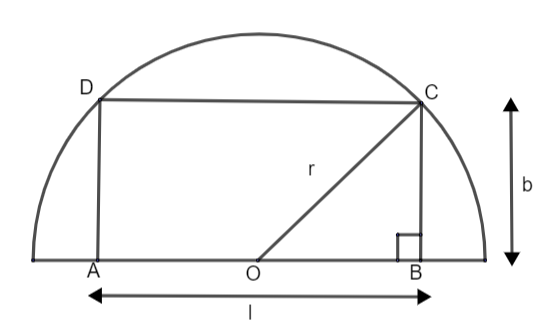Question
Question: How do you find the dimensions of the rectangle with the largest area that can be inscribed in a sem...
How do you find the dimensions of the rectangle with the largest area that can be inscribed in a semi – circle of radius r?
Solution
Draw a rough diagram of a semi – circle of radius ‘r’ and inscribe a rectangle in it such that one side of the rectangle lies on the diameter of the semi – circle and two vertices lie on its curved boundary. Join the centre of this semi – circle with the two vertices. Assume the length of the rectangle as ‘l’ while breadth as ‘b’. Now, use Pythagoras theorem given as: - h2=b2+p2, where h = hypotenuse, b = base and p = perpendicular, to find a relation between r, l and b. Use the formula: - Area = l×b to find the area of the rectangle. Now, substitute the value of l, in terms of r and b, in the area relation. Differentiate the area relation with respect to b and equate it equal to 0 and find the value of b in terms of r. Finally, substitute this value of b in Pythagoras relation to get the value of l in terms of r.
Complete step-by-step solution:
Here, we have been provided with a semi – circle of radius r and we have been asked to find the dimensions of the rectangle that will have maximum area when inscribed in this semi – circle.
Now, for the inscribed rectangle to have maximum area, its one side must lie on the diameter and the two vertices on the curved boundary of the semi – circle. So, let us draw a rough diagram of the given situation.

In the above figure, we have assumed l and b as the length and breadth of the rectangle respectively. Length l is divided into two equal parts at centre of the semi – circle. We have joined the centre (O) with vertex C.
Now, clearly we can see that OBC is a right angle triangle. So, applying the Pythagoras theorem given as: - h2=b2+p2, where h = hypotenuse, b = base and p = perpendicular, we get,
